Anti-tobacco movement in Nazi Germany
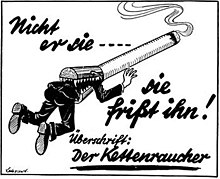
In the early 20th century, German researchers found
The German movement was the most powerful anti-smoking movement in the world during the 1930s and early 1940s.[1] Some[9] Nazi leaders condemned smoking[13] and several of them openly criticized tobacco consumption,[1] but others publicly smoked and denied that it was harmful.[9]
There was much research on smoking and its effects on health during Nazi rule,[14] and it was the most important of its type at that time.[15] A directly supported tobacco research institute produced work of only marginal scientific importance,[16] but substantial academic work was done privately, with little to negative official support.[3][9]
Adolf Hitler's personal distaste for tobacco[17] and the Nazi reproductive policies were among the motivating factors behind the Nazi campaigns against smoking.[18] The Nazi anti-tobacco campaign included banning smoking in trams, buses, and city trains,[1] promoting health education,[19] limiting cigarette rations in the Wehrmacht, organizing medical lectures for soldiers, and raising the tobacco tax.[1] The Nazis also imposed restrictions on tobacco advertising and smoking in public spaces, and regulated restaurants and coffeehouses.[1] However, these measures were widely circumvented or ignored.[9]
The movement did not reduce the
Prelude
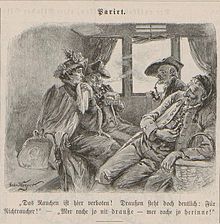
Anti-smoking measures have a long history in German-speaking areas. For instance, in 1840, the Prussian government reinstated a ban on smoking in public places.[9] The 1880s invention of automated cigarette-making machinery in the American South made it possible to mass-produce cigarettes at low cost, and smoking became common in Western countries. This led to a backlash and a tobacco prohibition movement, which challenged tobacco use as harmful and brought about some bans on tobacco sale and use.[22][23][24]
The
After World War I, anti-tobacco movements continued in the German Weimar Republic, against a background of increasing medical research. German researchers were heavily involved with early research into tobacco harms. In the 1920s and 1930s, the Weimar Republic was at the cutting edge of tobacco research.[12]
In 1920, a Bund Deutscher Tabakgegner in der Tschechoslowakei (Federation of German Tobacco Opponents in Czechoslovakia) was formed in
Research
Research on tobacco's effects on population health were more advanced in Germany than in any other nation by the time the Nazis came to power.
The term "
Further observational studies were done in Nazi Germany and the wartime Netherlands. Nazi Germany supported
After 1941, Nazi tobacco research was deliberately slowed,[36] along with other restrictions on anti-tobacco publications.[9] At the end of the war, the fates of those involved in supporting and carrying out research varied. Karl Astel, who was heavily involved in mass murder and research practices which would probably have seen him tried as a war criminal, killed himself.[8][16] Fritz Sauckel was executed for crimes against humanity. Leonardo Conti killed himself while awaiting trial for his involvement in mass murder of ill people. Hans Reiter (the Reich Health Office president) was interned for two years and spent the rest of his career in private practice.[1] Others worked in the field after the war; pharmacologist Gustav Kuschinsky continued work similar to that begun with funding from Astel's institute with funding from the cigarette company Reemtsma.[8] Fritz Lickint was appointed to public hospital and teaching posts again after the war.[3]
Many wartime research publications were never shipped abroad, and after the war, pre-war and wartime publications on nicotine were ignored even within Germany.
Political motives
Hitler's attitude towards smoking
Hitler viewed smoking as "decadent"
Hitler disapproved of the military personnel's freedom to smoke, and during World War II he said on 2 March 1942, "it was a mistake, traceable to the army leadership at the time, at the beginning of the war". He also said that it was "not correct to say that a soldier cannot live without smoking". He promised to end the use of tobacco in the military after the end of the war. Hitler personally encouraged close friends not to smoke. He even began to offer a gold watch to any of his inner circle who could quit. However, Hitler's personal distaste for tobacco was only one of several catalysts behind the anti-smoking campaign.[17]
Economic and antisemitic reasons
In the twenties, many German cigarette firms went bankrupt, and the market was increasingly dominated by a few large, highly automated manufacturers. By 1933, with high unemployment, the
Reproductive and health policies
The Nazi reproductive policies were a significant factor behind their anti-tobacco campaign.[18] The Nazi leadership wanted German women to have as many children as possible.[40] Articles and a major medical book published in the 1930s observed an association between smoking (in both men and women) and lower fertility, including more miscarriages.[3] The idea that male fertility was also affected by smoking was not a new one at that time.[3] An article published in a German gynecology journal in 1943 stated that women smoking three or more cigarettes per day were more likely to remain childless compared to nonsmoking women.[40] Martin Staemmler, a prominent physician during the Nazi era, said that smoking by pregnant women resulted in a higher rate of stillbirths and miscarriages (a claim supported by modern research, for nicotine-using mothers, fathers, and their offspring[41][42]). This view was also promoted in a 1936 book by well-known female racial hygienist Agnes Bluhm.[40]
Women who smoked were viewed as unsuitable to be wives and mothers in a German family.
There was also concern that mutations caused by cigarette smoking would have irreversible long-term effects on the genetics of the population.[3] Tobacco was described as a "genetic poison" (see epigenetic effects of smoking for modern research).[48] In Nazi rhetoric, these concerns were connected to racist theories about the "German germ plasm".[49]
Measures protecting non-smokers (especially children and mothers) from passive smoking were tied to the Nazi's desire for healthy young soldiers[36] and workers.[16] They were tied to the concepts of Volksgesundheit (People's Health) and Gesundheitspflicht (Duty to be Healthy). Physical fitness was promoted, and tobacco use was discouraged as incompatible with physical fitness.[9] Antismoking campaigns were accompanied by other health campaigns, such as discouraging the consumption of alcohol (especially during pregnancy) and encouraging the eating of fruit, vegetables, and whole-wheat bread.[18]
Measures
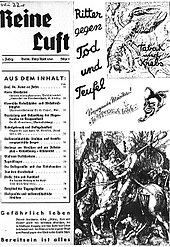
There was never a coherent Nazi policy to impede smoking. Mostly, measures were based on pre-existing policies. Although in some places some stern measures were taken, tobacco control policy was incoherent and ineffective, and obvious measures were not taken. Tobacco controls were often not enforced.[50] Smoking bans were widely ignored.[9] Measures reached their peak in 1939–1941,[1] after which some were rolled back or actively prevented.[9]
There was great regional variation in tobacco policies, making it possible to find wildly contradictory individual examples. Almost no anti-smoking efforts were made in Nazi Austria, for instance.[51] In Jena, Thuringia, very strong anti-smoking measures were enacted, due to the power of Karl Astel there and his support from Fritz Sauckel (the Gauleiter of Thuringia) and Leonardo Conti (the Reich Health Leader). These measures included the first 20th-century university campus smoking ban.[9][16] There were many small, local anti-tobacco measures, which were often unapproved and viewed negatively by the Nazi Party.[9]
The Nazi anti-tobacco policies were not free of contradictions. For example, the Volksgesundheit (People's Health) and Gesundheitspflicht (Duty to be Healthy) policies were enforced in parallel with the active distribution of cigarettes to people who the Nazis saw as "deserving" groups (e.g. frontline soldiers, members of the Hitler Youth). On the other hand, "undeserving" and stigmatized groups (Jews, war prisoners) were denied access to tobacco.[9]
Propaganda
The Nazis used several public relations tactics to convince the general population of Germany not to smoke, and gave variable support to non-officially-approved propaganda. National and local government organizations, party-controlled organizations, voluntary organizations, and medical organizations were all involved. The messages differed; propaganda by Nazi Party organizations generally described tobacco as harmful to women or young people, while publications by medical professionals tended to describe the health hazards of smoking.[9] In 1941, the propaganda ministry issued orders to "completely cease any anti-tobacco propaganda in the public", with minor exceptions, which had to be submitted for censorship.[9]
The Public Health Office repeatedly made precise public statements about the health harms of smoking (under both Gerhard Wagner and his successor, Leonardo Conti). The Reich Health Office also issued warnings, and the Reich Bureau Against the Dangers of Alcohol and Tobacco was founded.[52] In 1939, a Bureau against the Dangers of Alcohol and Tobacco was formed.[18] The anti-smoking campaign undertaken by the Nazis also included health education.[clarification needed][19][30][53]
The
Well-known health magazines like the Gesundes Volk (Healthy People),[34] Volksgesundheit (People's Health) and Gesundes Leben (Healthy Life)[54] also published warnings about the health consequences of smoking[34][54] and posters showing the harmful effects of tobacco were displayed.[34] Some anti-smoking posters were unapproved and censured by the government.[9] Editorials discussing the issue of smoking and its effects were published in newspapers.[55] Articles advocating nonsmoking were also published in the magazines Die Genussgifte (The Recreational Stimulants), Auf der Wacht (On the Guard) and Reine Luft (Clean Air).[56] Out of these magazines, Reine Luft was the main journal of the anti-tobacco movement.[1][8] Karl Astel's Institute for Tobacco Hazards Research at Jena University purchased and distributed hundreds of reprints from Reine Luft.[8] The magazine was published by tobacco control activists; it was later, in 1941, ordered by the propaganda ministry to moderate its tone and submit all material for pre-approval.[9]
Restrictions were imposed on the advertisement of tobacco products,
Nichtraucherschutz (the protection of non-smokers)
Nichtraucherschutz (the protection of non-smokers [from passive smoking]) was the principle behind some bans.[36] In 1941, tobacco smoking in trams was outlawed in sixty German cities.[60] In 1944, smoking in buses and city trains was made illegal,[21] on the personal initiative of Hitler, who feared female ticket collectors might be the victims of passive smoking.[1]
Smoking was also banned not only in health care institutions, but also in several public offices and in rest homes.
Women and children
Special care was taken to discourage pregnant women and youth from smoking.[36] The president of the Medical Association in Germany[clarification needed] announced, "German women don't smoke".[64] Pregnant women, and women below the age of 25 and over the age of 55, were not given tobacco ration cards during World War II. Restrictions on selling tobacco products to women were imposed on the hospitality and food retailing industry,[60] though restrictions on women smoking in restaurants were officially rejected by the Nazi party.[9] Anti-tobacco films aimed at women were publicly shown. Some local measures were quite strict; for instance, one district department of the National Socialist Factory Cell Organization (NSBO) announced that it would expel female members who smoked publicly.[55] Some women working in arms factories, however, were given special cigarette rations.[9]
Smoking was also banned inside many schools.[18][34] In July 1943, public smoking for persons under the age of 18 was outlawed,[18][54][60] although under-18s were still allowed to purchase and privately smoke tobacco.[9] The US and UK had less lenient regulations.[11][12]
Military regulations
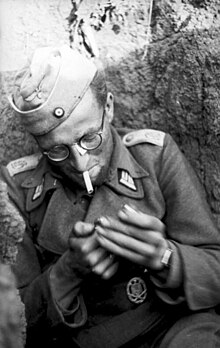
Restrictions on smoking were also introduced in the
In 1938, the Luftwaffe imposed a ban on smoking.[clarification needed][1] In 1939, Heinrich Himmler, the then chief of the Schutzstaffel (SS), restricted police personnel and SS officers from smoking while they were on duty.[60] The JAMA also reported that Hermann Göring had banned soldiers from smoking when on the streets, on marches, or only briefly off-duty.[1]
Countermeasures and obstacles

Tobacco companies represented themselves as strong and early supporters of the Nazi cause.
Some senior Nazi officials were opposed to anti-tobacco measures.
The tobacco industry worked to counter the government campaign to prevent women from smoking and used smoking models in their advertisements.[64] Fashion illustrations displaying women with cigarettes were often published in prominent publications such as the Beyers Mode für Alle (Beyers Fashion For All). The cover of the popular song Lili Marleen featured singer Lale Andersen holding a cigarette.[55]
The cigarette manufacturing companies in Germany made several attempts to weaken the scientific credibility of the anti-tobacco campaign. They tried to depict the anti-tobacco movement as "fanatic" and "unscientific".[1] They published new journals (with titles such as Chronica Nicotiana[2] and Der Tabak: Wissenschaftliche Zeitschrift der Internationalen Tabakwissenschaftlichen Gesellschaft,[1] or "Tobacco: the scientific journal of the International Tobacco Scientific Society"). One industry-funded tobacco counter-research institute, the Tabacologia medicinalis, was shut down by Reich Health Leader Leonardo Conti.[8] Another such "academy" was called Academia Nicotiana Internationalis.[2]
While some cigarette ads had been banned from Nazi party publications due to Jewish ownership, the publications lost money, and the early party needed money for election campaigning. In June 1932, Hitler personally made a deal for half a million marks worth of cigarette advertising.[38]
Economic pressures
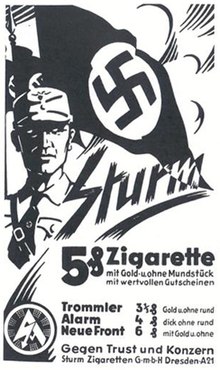
The Nazi paramilitary SA was funded by cigarette royalties.[39] After the Night of the Long Knives, the Reemtsma cigarette company paid a fixed fee (a quarter-million marks for the first year) to produce the SA's permitted cigarettes.[38] A plan to establish a state tobacco monopoly was not carried out.[67][66]
Efforts were made to keep cigarettes freely available. In the inter-war period, cigarettes were made with tobacco from Greece, Bulgaria, and Turkey. Pipe tobacco and cigar tobacco often came from overseas, so the war disrupted their availability.[36] The tobacco industry worked closely with occupying forces in the Crimea, where forced labour, including child labour, was used to harvest tobacco.[67] Forced labour was used in cigarette manufacture, with prison camps set up at some locations.[66] More cigarettes were made with less tobacco, to stretch the supply.[67] Demand was also controlled; "undeserving" groups were forbidden to enter tobacconists, and later from buying tobacco.[36][9]
An ordinance enacted on 3 November 1941 raised tobacco taxes by approximately 80–95% of the retail price. It would be the highest rise in tobacco taxes in Germany until more than 25 years after the collapse of the Nazi regime.[1] By 1941, tobacco taxes made up about a twelfth of state income, and antismoking efforts were being discouraged.[9]
Despite these efforts, in 1942 there was a shortage of tobacco, and 2/3 of all German tobacco factories were shut down,
Effectiveness
The early anti-smoking campaign was considered a failure, and from 1933 to 1937 there was a rapid increase in tobacco consumption in Germany.
Free and subsidized branded cigarettes were
| Year | ||||
| 1930 | 1935 | 1940 | 1944 | |
| Germany | 490 | 510 | 1,022 | 743 |
| United States | 1,485 | 1,564 | 1,976 | 3,039 |
Smoking was common in the Wehrmacht; a 1944 survey found that 87% of servicemen smoked. 10% of servicemen had begun smoking while in the military, and only seven servicemen of the thousand surveyed (0.7%) had given it up.[1] However, as in the general population, the number of smokers rose while the number of cigarettes smoked fell. As a result of the anti-tobacco measures implemented in the Wehrmacht (supply restriction, taxes, and propaganda),[1] the total tobacco consumption by soldiers decreased between 1939 and 1945.[21] Average tobacco consumption per person among military personnel declined by 23.4% compared to the immediate pre-World War II years. The number of servicemen who smoked 30 or more cigarettes per day (well above the theoretical maximum military ration of 7.7 cigarettes per day)[78] declined from 4.4% to 0.3%.[1]
Association with antisemitism and racism
Apart from public health concerns, the Nazis were heavily influenced by ideology;[34] specifically, the movement was influenced by concepts of "racial hygiene" and bodily purity.[48] Some Nazi leaders believed that it was wrong for the "master race" to smoke[34] and that tobacco consumption was equal to "racial degeneracy".[79] Tobacco-caused infertility[40] and hereditary damage (described in now-obsolete terms as "corrupt[ion]" of the "germ plasm") were considered problematic by the Nazis on the grounds that they harmed German "racial hygiene".[49]
Nazi anti-tobacco activists often tried to depict tobacco as a vice of "the degenerate
After World War II

After the collapse of Nazi Germany at the
Nazi-related rhetoric associating anti-smoking measures with fascism has been fairly widely used in nicotine marketing[9] (except in Germany, where such comparisons have brought strong reactions).[10] Historical research has been quoted in a selective manner, which has been criticized by the quoted historians.[9] In the early 21st century, this Nazi rhetoric may be being supplanted by Taliban-related rhetoric associating anti-smoking measures with theocracy.[10]
It has been argued that the Nazi anti-tobacco campaigns delayed effective
See also
- Animal welfare in Nazi Germany
- Health effects of tobacco § History
- History of nicotine marketing § 1914–1950
- Fritz Lickint
- Sturm-Zigaretten(the Nazi Party's cigarette company)
References
Citations
- ^ PMID 8973234.
- ^ PMID 22345227.
- ^ a b c d e f g h i j Haustein KO (2004), "Fritz Lickint (1898-1960) – Ein Leben als Aufklärer über die Gefahren des Tabaks", Suchtmed (in German), 6 (3): 249–255, archived from the original on November 5, 2014
- ^ a b c Young 2005, p. 252
- ^ a b Szollosi-Janze 2001, p. 15
- S2CID 154707. Archived from the original(PDF) on 2018-10-01. Retrieved 2008-06-01.
Societies were formed to discourage smoking at the beginning of the century in several countries, but they had little success except in Germany where they were officially supported by the government after the Nazis seized power.
- ^ Borio G (1993–2003). "Tobacco Timeline: The Twentieth Century 1900-1949—The Rise of the Cigarette". Tobacco News. Archived from the original on 17 October 2008. Retrieved 2008-11-15.
- ^ PMID 11171846, archived from the originalon 2006-09-03, retrieved 2008-08-24
- ^ PMID 18222506
- ^ PMID 18818222.
- ^ doi:10.1016/S0014-4983(02)00005-0. Archived from the original(PDF) on 2017-08-12. Retrieved September 4, 2017.
- ^ S2CID 154707. Archived from the original(PDF) on 2018-10-01. Retrieved 2018-09-30.
- ^ Bynum et al. 2006, p. 375
- ^ a b Proctor RN (1996). "Nazi Medicine and Public Health Policy". Dimensions. Anti-Defamation League. Archived from the original on 31 May 2008. Retrieved 2008-06-01.
- ^ Clark, Briggs & Cooke 2005, pp. 1373–74
- ^ PMID 11171847.
- ^ a b c d e Proctor 1999, p. 219
- ^ PMID 15604167.
- ^ a b Gilman & Zhou 2004, p. 328
- ^ a b c d e Proctor 1999, p. 228
- ^ a b c d e f Clark, Briggs & Cooke 2005, p. 1374
- .
- ^ a b James R (2009-06-15). "A Brief History Of Cigarette Advertising". Time. Archived from the original on September 21, 2011. Retrieved 2012-03-25.
- ^ "The anti-tobacco reform and the temperance movement in Australia: connections and differences. - Free Online Library". Retrieved 2018-05-19.
- ^ S2CID 39160045, archived from the original(PDF) on 2008-10-14, retrieved 2008-07-22,
The first German antitobacco organization was established in 1904 (the short-lived Deutscher Tabakgegnerverein zum Schutze für Nichtraucher); this was followed by a Bund Deutscher Tabakgegner based in the town of Trautenau, in Bohemia (1910), and similar associations in Hanover and Dresden (both founded in 1912). When Czechoslovakia was severed from Austria after the First World War, a Bund Deutscher Tabakgegner in der Tschechoslowakei was established in Prague (1920); that same year in Graz a Bund Deutscher Tabakgegner in Deutschösterreich was founded.
- ^ Proctor 1999, p. 177
- ^ Proctor 1999, p. 178
- PMID 8051518.
- ^ a b c Proctor 1999, p. 173
- ^ PMID 15746205, archived from the originalon 9 July 2008, retrieved 2008-06-01
- ^ Schaler 2004, p. 155
- ^ a b c Proctor 1999, p. 187
- ^ a b Proctor 1999, p. 207
- ^ a b c d e f g h i Coombs & Holladay 2006, p. 98
- ^ Proctor 1999, p. 194
- ^ ISSN 0931-9085. Retrieved 2018-08-27.
- ^ Tillman 2004, p. 119
- ^ a b c d e Erik Lindner. "Zwölf Millionen für Göring". Cicero Online. Retrieved 2018-08-20.
- ^ a b c Daniel Siemens (2013-09-11). "Nazi storm-troopers' cigarettes" (University department). UCL SSEES Research Blog. Retrieved 2018-08-25.
- ^ a b c d Proctor 1999, p. 189
- PMID 20363831.
Overall, the evidence provided in this review overwhelmingly indicates that nicotine should no longer be considered the safe component of cigarette smoke. In fact, many of the adverse postnatal health outcomes associated with maternal smoking during pregnancy may be attributable, at least in part, to nicotine alone.
- PMID 20225987.
The use of any products containing nicotine likely will have adverse effects of fetal neurological development.
- S2CID 8076552, archived from the originalon 2012-06-30, retrieved 2008-11-15
- S2CID 25780574, archived from the original(PDF) on 2016-03-04, retrieved 2008-11-15
- PMID 17766521
- S2CID 43473398, retrieved 2008-11-17
- PMID 17951030.
- ^ a b c Proctor 1999, p. 174
- ^ a b c Proctor 1999, p. 179
- PMID 18222506.
- PMID 17705984.
- ^ PMID 7866221
- ^ Berridge 2007, p. 13
- ^ PMID 8051518
- ^ a b c d Guenther 2004, p. 108
- ^ Proctor 1999, p. 199
- ^ Uekoetter 2006, p. 206
- ^ Proctor 1999, p. 204
- ^ Proctor 1999, p. 206
- ^ a b c d e Proctor 1999, p. 203
- ^ Evans R (2006). The Third Reich in Power. New York, NY: Penguin. p. 482.
- ^ PMID 29019774.
- ^ Evans R (2006). The Third Reich in Power. New York, NY: Penguin. p. 522.
- ^ a b Daunton & Hilton 2001, p. 169
- ^ Meyer 2005, p. 13
- ^ a b c d "Rauchzeichen: Fotoarchiv Reemtsma in der NS-Zeit" (Museum). Retrieved 2018-08-25.
- ^ a b c Klawitter N (2011-08-23). "Reemtsmas Zwangsarbeiter: Tabakrausch im Osten". Spiegel Online.
- ^ Lee 1975
- PMID 18222506.
- ^ David M. Burns, Lora Lee, Larry Z. Shen, Elizabeth Gilpin, H. Dennis Tolley, Jerry Vaughn, Thomas G. Shanks. "Cigarette Smoking Behavior in the United States" (PDF). Smoking and Tobacco Control Monograph No. 8.
- ^ PMID 8436896.
- ^ Office on Smoking and Health (2001). "Chapter 2. Patterns of Tobacco Use among Women and Girls". Women and Smoking: A Report of the Surgeon General. Atlanta: Centers for Disease Control and Prevention (US).
- ^ The Cancer Council. "A brief history of tobacco smoking in Australia". Tobacco In Australia: Facts and Issues. Archived from the original on 2018-10-09. Retrieved 2018-10-09.
- ISSN 0190-8286. Retrieved 2018-05-27.
- ^ "Burden of Tobacco Use in the U.S.: Current Cigarette Smoking Among U.S. Adults Aged 18 Years and Older". Centers for Disease Control and Prevention. 2019-06-18.
- S2CID 26903942. Archived from the original(PDF) on 2017-08-09. Retrieved 2018-11-19.
- S2CID 11356233.
- ^ A ration of six cigarettes per day, plus a maximum purchase of 50 per month of 29.5 days,[1] gives a maximum of 7.7 cigarettes per day
- ^ Proctor 1999, p. 220
- ^ Proctor 1999, p. 208
- ^ Proctor 1999, p. 245
- ^ Zigarettenwerbung in Deutschland – Marketing für ein gesundheitsgefährdendes Produkt (PDF). Rote Reihe: Tabakprävention und Tabakkontrolle. Heidelberg: Deutsches Krebsforschungszentrum. 2012. Retrieved 2016-05-01.
- ^ Dr. Annette Bornhäuser, Dr. med. Martina Pötschke-Langer (2001). Factsheet Tabakwerbeverbot (PDF). Deutsches Krebsforschungszentrum. Retrieved 2016-05-01.
Sources
- Berridge V (2007), Marketing Health: Smoking and the Discourse of Public Health in Britain, 1945-2000, ISBN 978-0-19-926030-0.
- Bynum WF, Hardy A, Jacyna S, Lawrence C, Tansey EM (2006), The Western Medical Tradition, ISBN 978-0-521-47524-2.
- Clark GN, Briggs A, Cooke AM (2005), "A History of the Royal College of Physicians of London", British Medical Journal, 1 (5427), Oxford University Press: 79–82, PMID 14218483.
- Coombs WT, Holladay SJ (2006), It's Not Just PR: Public Relations in Society, ISBN 978-1-4051-4405-6.
- Daunton M, Hilton M (2001), The Politics of Consumption: Material Culture and Citizenship in Europe and America, ISBN 978-1-85973-471-1.
- Gilman SL, Zhou X (2004), Smoke: A Global History of Smoking, Reaktion Books, ISBN 978-1-86189-200-3.
- Guenther I (2004), Nazi Chic?: Fashioning Women in the Third Reich, Berg Publishers, ISBN 978-1-85973-400-1.
- Lee PN (1975), "Tobacco Consumption in Various Countries", Nature, 202 (4937) (4th ed.): 1062, S2CID 4245143.
- Meyer H (2005), The 12th SS: The History of the Hitler Youth Panzer Division, Stackpole Books, ISBN 978-0-8117-3198-0.
- Proctor R (1999), The Nazi War on Cancer, ISBN 978-0-691-07051-3.
- Schaler JA (2004), Szasz Under Fire: A Psychiatric Abolitionist Faces His Critics, ISBN 978-0-8126-9568-7.
- Szollosi-Janze M (2001), Science in the Third Reich, Berg Publishers, ISBN 978-1-85973-421-6.
- Tillman B (2004), Brassey's D-Day Encyclopedia: The Normandy Invasion A-Z, Potomac Books Inc., ISBN 978-1-57488-760-0.
- Uekoetter F (2006), The Green and the Brown: A History of Conservation in Nazi Germany, Cambridge University Press, ISBN 978-0-521-84819-0.
- Young TK (2005), Population Health: Concepts and Methods, Oxford University Press, ISBN 978-0-19-515854-0.
Further reading
- Bachinger E, McKee M (September 2007), "Tobacco policies in Austria during the Third Reich", The International Journal of Tuberculosis and Lung Disease, 11 (9): 1033–7, PMID 17705984
- Bachinger E, McKee M, Gilmore A (May 2008). "Tobacco policies in Nazi Germany: not as simple as it seems". Public Health. 122 (5): 497–505. PMID 18222506.
- Brooks A (19 January 1996), "Guest Column: Forward to the Past", The Daily Californian
- Doll R (2001), "Commentary: Lung cancer and tobacco consumption", International Journal of Epidemiology, 30 (1): 30–31, doi:10.1093/ije/30.1.30, archived from the originalon 2009-04-14
- Nicosia FR, Huener J (2002), Medicine and Medical Ethics in Nazi Germany, Berghahn Books, ISBN 978-1-57181-386-2
- Petrick-Felber N (2015). Kriegswichtiger Genuss: Tabak und Kaffee im "Dritten Reich". Beiträge zur Geschichte des 20. Jahrhunderts (in German). Göttingen: Wallstein Verlag. )
- Proctor RN (1988), Racial Hygiene: Medicine Under the Nazis, ISBN 978-0-674-74578-0
- Proctor RN (2018), The Nazi War on Cancer (2nd ed.), Princeton University Press, ISBN 9780691187815
- Proctor RN (1999), "Why did the Nazis have the world's most aggressive anti-cancer campaign?", Endeavour, 23 (2): 76–9, PMID 10451929
